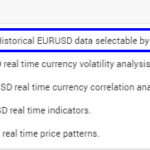The euro experienced a dip against the US dollar, briefly touching its lowest point since February 12th, trading at $1.04. This fluctuation occurred as investors carefully analyzed recent economic data and anticipated the European Central Bank’s (ECB) upcoming policy meeting. Market sentiment was further influenced by US President Donald Trump’s announcement of tariffs on goods from Mexico, Canada, and China, alongside planned tariffs on EU imports.
This move reflects a broader market reaction to economic indicators and geopolitical developments. Germany’s inflation remained steady at 2.3% in February, but its core inflation rate decreased to a three-year low of 2.6%. Meanwhile, France saw a more significant drop in inflation to a four-year low of 0.8%. Conversely, Italy and Spain both reported inflation increases to 1.7% and 3% respectively, aligning with market expectations. These mixed inflation signals across major Eurozone economies add complexity to the ECB’s policy decisions.
The ECB is widely anticipated to implement a fifth consecutive interest rate cut at its upcoming Thursday meeting. This expectation is fueled by concerns over slowing inflation and weakened economic growth across the Eurozone. Market analysts are closely watching for signals of further rate reductions, as these will heavily influence the euro’s trajectory against the dollar.
On Friday, February 28th, the EURUSD exchange rate decreased by 0.0021 or 0.20%, settling at 1.0378, down from 1.0398 in the previous trading session. Historically, the Euro US Dollar exchange rate reached a peak of 1.87 in July 1973. While the euro as a currency was officially introduced on January 1, 1999, historical data can be modeled using a weighted average of previous European currencies to understand long-term trends.
Short-Term and Long-Term EUR/USD Forecasts
Current models and analyst expectations from Trading Economics suggest the EUR/USD exchange rate is anticipated to trade around 1.03 by the end of the current quarter. Looking ahead, projections estimate a further decrease to 1.01 within 12 months.
These forecasts are based on a combination of factors, including the anticipated ECB policy easing, persistent concerns about Eurozone economic growth, and the strength of the US dollar, potentially bolstered by factors such as US interest rate policy and economic performance. The impact of international trade tensions and tariff policies also adds a layer of uncertainty to these predictions.
| Crosses | Price | Day | Year | Date |
|---|---|---|---|---|
| EURUSD | 1.0378 | -0.0021 | -0.20% | -3.94% |
| EURGBP | 0.8253 | 0.0001 | 0.01% | -3.55% |
| EURAUD | 1.6717 | 0.0043 | 0.25% | 0.54% |
| EURNZD | 1.8533 | 0.0077 | 0.42% | 4.42% |
| EURJPY | 156.2815 | 0.5015 | 0.32% | -3.56% |
| EURCNY | 7.5694 | -0.0216 | -0.28% | -2.54% |
| EURCHF | 0.9372 | 0.0016 | 0.17% | -1.93% |
| EURCAD | 1.5001 | -0.0010 | -0.06% | 2.26% |
| EURMXN | 21.3261 | 0.0242 | 0.11% | 15.85% |
| EURINR | 90.6642 | -0.1452 | -0.16% | 1.24% |
| EURBRL | 6.1040 | 0.0299 | 0.49% | 13.40% |
| EURKRW | 1,516.9672 | 8.3630 | 0.55% | 4.94% |
| EURIDR | 17,159.5302 | -60.5976 | -0.35% | 1.11% |
| EURPLN | 4.1911 | 0.0271 | 0.65% | -2.78% |
| EURSEK | 11.2122 | 0.0310 | 0.28% | 0.07% |
| EURCZK | 25.0660 | 0.0720 | 0.29% | -1.00% |
| EURHUF | 406.1320 | 5.4815 | 1.37% | 3.68% |
| EURNOK | 11.6815 | -0.0107 | -0.09% | 1.89% |
| EURZAR | 19.3963 | 0.1992 | 1.04% | -6.47% |
The euro to dollar exchange rate remains a key indicator for global markets, influenced by a complex interplay of economic policies, inflation trends, and international trade dynamics. Investors and businesses alike will continue to monitor these factors closely to navigate the fluctuating currency landscape.

